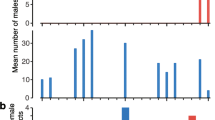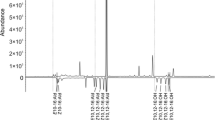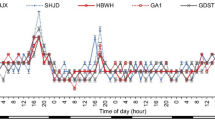Abstract
The relationship between pheromone composition and mitochondrial haplotype clades was investigated by coupling DNA analyses with pheromone identification and male mate searching behavior among different geographic populations of Busseola fusca. The within-population variations in pheromone blend were as great as those observed between geographic populations, suggesting that the female sex pheromone blend was not the basis of reproductive isolation between the geographic clades. Furthermore, while data from wind tunnel experiments demonstrated that most of the tested males were sensitive to small variations in pheromone mixture, there was considerable within-population variability in the observed response. The study identified a new pheromone component, (Z)-11-hexadecen-1-yl acetate, which when added to the currently used three-component synthetic blend resulted in significantly higher traps catches. The new recommended blend for monitoring flight phenology and for timing control measures for optimal efficacy of B. fusca is (Z)-11-tetradecen-1-yl acetate (62%), (E)-11-tetradecen-1-yl acetate (15%), (Z)-9-tetradecen-1-yl acetate (13%), and (Z)-11-hexadecen-1-yl acetate (10%).



Similar content being viewed by others
References
Baker, T. C. 1990. Upwind flight and casting flight: complimentary phasic and tonic systems used for location of sex pheromone sources by male moths, pp. 18–25, in K. B. Doving (ed.). International Symposium on Olfaction and Taste X, Graphic Communication Systems, Oslo.
Baker, T. C., and Haynes, K. F. 1996. Pheromone-mediated optomotor anemotaxis and altitude control exhibited by male oriental fruit moths in the field. Physiol. Entomol. 21:20-32.
Calatayud, P.-A., Guenego, H., Le Rü, B. P., Silvain, J. F., and Frérot, B. 2007. Temporal patterns of emergence, calling behaviour and oviposition period of the maize stem borer, Busseola fusca (Fuller) (Lepidoptera: Noctuidae). Ann. Soc. Entomol. France 43:63-68
Chambers, J., and R Development Core Team, 2006. A language and environment for Statistical Computing. Vienna, Austria. ISBN 3-900051-07-0, www.R-project.org
Frérot, B., and Foster, S. P. 1991. Sex pheromone evidence for two distinct taxa within Graphania mutans (Walker). J. Chem. Ecol. 17:2077-2093.
Frérot, B., Malosse, C., and Cain, A. H. 1997. Solid-Phase Microextraction (SPME): A new tool in pheromone identification in Lepidoptera. J. High Resol. Chromatogr. 20:340-342.
Georgin, J.-P. 2002. Analyse intéractive des données (ACP, AFC) avec Excel 2000. Presses Universitaires de Rennes.
Kfir, R., Overholt, A. W., Khan, R. Z., and Polaszek, A. 2002. Biology and management of economically important lepidopteran cereal stem borers in Africa. Annu. Rev. Entomol. 47:701-731.
Le Rü, B. P., Ong'amo, G. O., Moyal, P., Muchugu, E., Ngala, L., Musyoka, B., Abdullah, Z., Matama-Kauma, T., Lada, V. Y., Pallangyo, B., Omwega, C. O., Schulthess, F., Calatayud, P. A., and Silvain, J. F. 2006. Geographic distribution and host plant ranges of East African noctuid stem borers. Ann. Soc. Entomol. France 42:353-361.
Ndemah, R., and Schulthess, F. 2002. Yield of maize in relation to natural field infestations and damage by lepidopterous borers in the forest and forest/savannah transition zones of Cameroon. Insect Sci. Appl. 22:183-193.
Nesbitt, B. F., Beevor, P. S., Cork, A., Hall, D. R., Lester, R., Blair, B. W., and Tannock, J. 1980. Identification of the female sex pheromone of the maize stalk borer, Busseola fusca: a preliminary note. Trop. Pest Manag. 26:327.
Ong'amo, G. O., Le Rü, B. P., Dupas, S., Moyal, P., Calatayud, P. A., and Silvain, J. F. 2006. Distribution, pest status and agro-climatic preferences of lepidopteran stem borers of maize in Kenya. Ann. Soc. Entomol. France 42:171-177.
Paterson, H. E. H. 1985. The recognition concept of species, 21–29, in Species and Speciation, E. S. VRBA, Pretoria.
Pelozuelo, L., Malosse, C., Genestier, G., Guenego, H., and Frérot, B. 2004. Host-plant specialization in pheromone strains of the European corn borer Ostrinia nubilalis in France. J. Chem. Ecol. 30:335-352.
Sezonlin, M., Dupas, S., Ru, B. L., Gall, P. L., Moyal, P., Calatayud, P. A., Giffard, I., Faure, N., and Silvain, J. F. 2006. Phylogeography and population genetics of the maize stalk borer Busseola fusca (Lepidoptera, Noctuidae) in sub-Saharan Africa. Mol. Ecol. 15:407-420.
Acknowledgments
We are grateful to Peter Mwatha Njoroge and Joseph Njoroge Mwatha for helping us run the field trapping at Maimahiu (Rift Valley, Kenya). Thanks are also given to Peter O. Ahuya for help and to Anthony Wanjoya and Hervé Guénégo for technical assistance. The authors are grateful to Jeremy Mc Neil and Fritz Schulthess for all valuable comments and revision of English.
Author information
Authors and Affiliations
Corresponding author
Rights and permissions
About this article
Cite this article
Félix, AE., Genestier, G., Malosse, C. et al. Variability in Pheromone Communication Among Different Haplotype Populations of Busseola fusca . J Chem Ecol 35, 618–623 (2009). https://doi.org/10.1007/s10886-009-9638-0
Received:
Revised:
Accepted:
Published:
Issue Date:
DOI: https://doi.org/10.1007/s10886-009-9638-0




